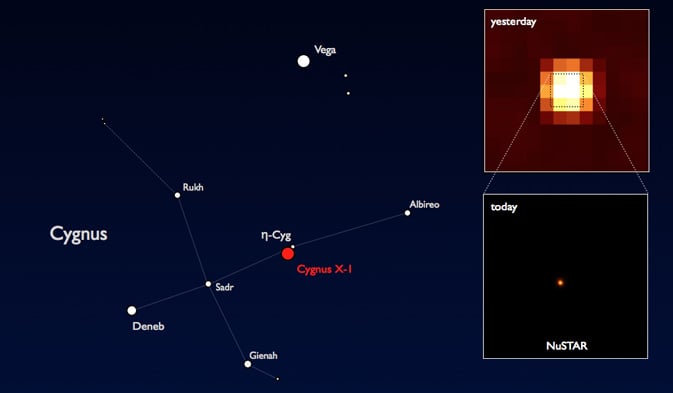Here is the first image taken by the newest space mission, NuSTAR, or the Nuclear Spectroscopic Telescope Array, the first space telescope with the ability to see the highest energy X-rays in our universe and produce crisp images of them.
"Today, we obtained the first-ever focused images of the high-energy X-ray universe," said Fiona Harrison, the mission's principal investigator. "It's like putting on a new pair of glasses and seeing aspects of the world around us clearly for the first time."
With the successful "first light" images, the mission will begin its exploration of the most elusive and energetic black holes -- as well as other areas of extreme physics in our cosmos -- to help in our understanding of the structure of the universe.
The first images show Cygnus X-1, a black hole in our galaxy that is siphoning gas off a giant-star companion. This particular black hole was chosen as a first target because it is extremely bright in X-rays, allowing the NuSTAR team to easily see where the telescope's focused X-rays are falling on the detectors.
NuSTAR launched on June 13 and its lengthy mast, which provides the telescope mirrors and detectors with the distance needed to focus X-rays, was deployed on June 21. The NuSTAR team spent the next week verifying the pointing and motion capabilities of the satellite, and fine-tuning the alignment of the mast.
The mission's primary observing program is expected to start in about two weeks. But before it does, the team will continue tests and point the NuSTAR at two other bright calibration targets: G21.5-0.9, the remnant of a supernova explosion that occurred several thousand years ago in our own Milky Way galaxy; and 3C273, an actively feeding black hole, or quasar, located 2 billion light-years away at the center of another galaxy. These targets will be used to make a small adjustment to place the X-ray light at the optimum spot on the detector, and to further calibrate and understand the telescope in preparation for future science observations.
Other targets for the mission include the burnt-out remains of dead stars, such as those that exploded as supernovae; high-speed jets; the temperamental surface of our sun; and the structures where galaxies cluster together like mega-cities.
"This is a really exciting time for the team," said Daniel Stern, the NuSTAR project scientist. "We can already see the power of NuSTAR to crack open the high-energy X-ray universe and reveal secrets that were impossible to get at before."
Lead image caption: NASA's Nuclear Spectroscopic Telescope Array, or NuSTAR, has taken its first snapshots of the highest-energy X-rays in the cosmos (lower right), producing images that are much crisper than previous high-energy telescopes (example in upper right). NuSTAR chose a black hole in the constellation Cygnus (shown in the skymap on the left) as its first target due to its brightness. Image credit: NASA/JPL-Caltech
 Universe Today
Universe Today
